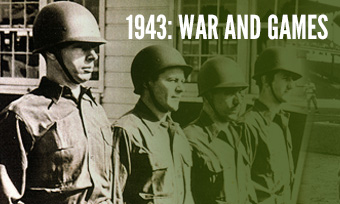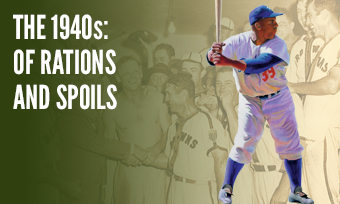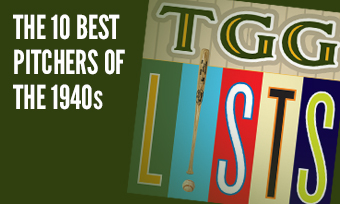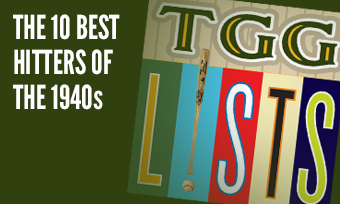The Yearly Reader
Leaders and Honors, 1943
Our list of baseball’s top 10 hitters and pitchers in both the American League and National League for the 1943 baseball season, as well as the awards and honors given to the game’s top achievers of the year.
The National League’s Top 10 Hitters, 1943
Bold type in brick red indicates league leader.
1. Stan Musial, St. Louis
Key Numbers: 157 games, .357 average, 108 runs, 220 hits, 48 doubles, 20 triples, 13 home runs, 81 RBIs, 72 walks, .425 on-base percentage, .562 slugging percentage.
Musial owned NL pitching in what some at the time believed was a deceiving case of overblown numbers against diluted wartime pitching. They had no idea.
2. Bill Nicholson, Chicago
Key Numbers: .309 average, 95 runs, 188 hits, 30 doubles, 9 triples, 29 home runs, 128 RBIs, 71 walks.
Nicholson led the NL in homers, something of a surprise given that neither he nor the Cubs homered until their 33rd game; he would be the only National Leaguer with at least 20 homers in 1943, let alone nearly 29.
3. Bob Elliott, Pittsburgh
Key Numbers: .315 average, 82 runs, 183 hits, 30 doubles, 12 triples, 7 home runs, 101 RBIs.
Ineligible for military service due to “head injuries,” Elliott had the first of three straight 100+ RBI seasons for the Pirates.
4. Arky Vaughan, Pittsburgh
Key Numbers: .305 average, 112 runs, 186 hits, 39 doubles, 6 triples, 5 home runs, 66 RBIs, 60 walks, 20 stolen bases, 11 caught stealing.
After a subpar year at the plate hindered, perhaps, by a move to third base, Vaughan returned to shortstop and experienced a revival in his hitting game.
5. Phil Cavarretta, Chicago
Key Numbers: .291 average, 93 runs, 27 doubles, 9 triples, 8 home runs, 73 walks, 75 walks.
At the halfway point of a 20-year career with the Cubs he began at age 18, Cavarretta finally found his footing as a borderline star outfielder at Wrigley.
6. Billy Herman, Brooklyn
Key Numbers: .330 average, 76 runs, 193 hits, 41 doubles, 2 home runs, 100 RBIs, 66 walks.
A vintage effort that spurred memories of his peak years with the Cubs of the mid-1930s; only Pie Traynor (in 1931) knocked in more runs on as few or equal number of home runs since the end of the Deadball Era.
7. Augie Galan, Brooklyn
Key Numbers: 139 games, .287 average, 83 runs, 26 doubles, 9 home runs, 67 RBIs, 103 walks.
The former Cubs star from the mid-1930s experienced a wartime-fueled revival, making his first All-Star Game appearance in nine years.
8. Lou Klein, St. Louis
Key Numbers: .287 average, 91 runs, 180 hits, 28 doubles, 14 triples, 7 home runs, 62 RBIs.
In the only full-time campaign of his major league career, Klein did more than just fill the war-created talent void; he performed sharp at a second base position that had been one of the Cardinals’ weakest spots in recent years.
9. Elbie Fletcher, Pittsburgh
Key Numbers: .283 average, 91 runs, 24 doubles, 5 triples, 9 home runs, 70 RBIs, 95 walks.
Before departing for the Navy, Fletcher just missed accumulating 100 walks and a .400+ on-base percentage for the first time in four years.
10. Ray Sanders, St. Louis
Key Numbers: .280 average, 21 doubles, 11 home runs, 73 RBIs, 77 walks.
Like Klein, Sanders filled another hole at St. Louis, this one at first base formerly owned by Johnny Mize. Unlike Klein, he’d hang out as a valuable asset for the wartime Cardinals.
The American League’s Top 10 Hitters, 1943
1. Rudy York, Detroit
Key Numbers: 155 games, .271 average, 90 runs, 22 doubles, 11 triples, 34 home runs, 118 RBIs, 84 walks, .527 slugging percentage.
One of the few pre-war stars who neither enlisted nor got drafted, York all but had the AL to himself. Half of his home runs were belted in August alone.
2. Charlie Keller, New York
Key Numbers: .271 average, 97 runs, 31 home runs, 86 RBIs, 106 walks.
“King Kong” became the guy in the Yankees’ lineup, but only for a year as even he would soon be gone, becoming U.S. Naval material; unlike other star ballplayers, he wouldn’t see any time playing for wartime teams.
3. George Case, Washington
Key Numbers: .294 average, 102 runs, 180 hits, 36 doubles, 5 triples, 61 stolen bases.
No American Leaguer stole more bases in any year between 1931 and 1968 than Case, who led the league for the fifth straight season.
4. Nick Etten, New York
Key Numbers: .271 average, 78 runs, 35 doubles, 5 triples, 14 home runs, 107 RBIs, 76 walks.
Classified 4-F by the military (thus allowed to keep playing in the majors), Etten began a productive wartime tenure with baseball’s gold standard (Yankees) after being traded from its disaster zone (the bankrupt Phillies).
5. Luke Appling, Chicago
Key Numbers: 155 games, .328 average, 192 hits, 33 doubles, 3 home runs, 80 RBIs, 90 walks, 27 stolen bases, .419 on-base percentage.
At age 36, Appling became the oldest AL batting champion (until Ted Williams) with the lowest league-leading average since 1908.
6. Vern Stephens, St. Louis
Key Numbers: 137 games, .289 average, 27 doubles, 22 home runs, 91 RBIs.
Nearly half of Stephens’ 22 home runs came within five multi-homer games.
7. Jeff Heath, Cleveland
Key Numbers: 118 games, .274 average, 22 doubles, 18 home runs, 79 RBIs, 63 walks.
Heath hit twice as many homers as any of his Cleveland teammates despite missing nearly 40 games on the season.
8. Dick Wakefield, Detroit
Key Numbers: 155 games, .316 average, 633 at-bats, 91 runs, 200 hits, 38 doubles, 8 triples, 7 home runs, 79 RBIs.
Baseball’s first bonus baby looked to be on target to meeting lofty expectations with a strong rookie showing—but it’s as good as it got for him.
9. Stan Spence, Washington
Key Numbers: .267 average, 23 doubles, 10 triples, 12 home runs, 88 RBIs, 84 walks.
The lifeless balata ball was particularly rough on Spence’s batting average, but the re-introduction of the ‘normal’ ball pumped his numbers back up to productive levels.
10. Mickey Vernon, Washington
Key Numbers: .268 average, 89 runs, 29 doubles, 8 triples, 7 home runs, 70 RBIs, 67 walks, 24 stolen bases, 10 hit-by-pitches.
The young first baseman warmed up toward better times after the war, in advance of two years’ worth of military service.
The National League’s Top 10 Pitchers, 1943
1. Mort Cooper, St. Louis
Key Numbers: 2.30 ERA, 21 wins, 8 losses, .724 win percentage, 37 appearances, 32 starts, 24 complete games, 6 shutouts, 274 innings, 12 intentional walks.
Cooper leveled off a smidgen from his breakout display of a year earlier, but clearly remained the NL’s best pitcher; he threw one-hit shutouts in back-to-back starts late in the spring.
2. Max Lanier, St. Louis
Key Numbers: 1.90 ERA, 15 wins, 7 losses, .682 win percentage, 32 appearances, 25 starts, 213.1 innings.
Lanier joined Cardinals teammates Cooper and Howie Pollett as the three top ERA leaders in the NL.
3. Hi Bithorn, Chicago
Key Numbers: 2.60 ERA, 18 wins, 12 losses, 39 appearances, 30 starts, 7 shutouts, 249.2 innings.
The majors’ first Puerto Rican, Bithorn was one of many to have a rising career severed by military service.
4. Rip Sewell, Pittsburgh
Key Numbers: 2.54 ERA, 21 wins, 9 losses, .700 win percentage, 35 appearances, 31 starts, 25 complete games, 265.1 innings, 12 intentional walks.
Sewell’s excuse for avoiding the military was a hunting accident in which he lost a small part of his foot—on December 7, 1941.
5. Whit Wyatt, Brooklyn
Key Numbers: 2.49 ERA, 14 wins, 5 losses, .737 win percentage, 26 starts, 180.2 innings, 43 walks.
The early 1940s ace was used more sparingly—but was still getting the job done—as his arm began to tire at age 36.
6. Johnny Vander Meer, Cincinnati
Key Numbers: 2.87 ERA, 15 wins, 16 losses, 36 starts, 21 complete games, 289 innings, 162 walks, 174 strikeouts, 33 grounded into double plays, five stolen bases allowed, 14 caught stealing.
The Reds’ wild child led the NL for a third straight year in strikeouts but set a career high in walks; for the next two years, he’d be featuring for the Sampson Naval Training Station team.
7. Elmer Riddle, Cincinnati
Key Numbers: 2.63 ERA, 21 wins, 11 losses, 3 saves, 36 appearances, 33 starts, 260.1 innings, 107 walks.
Two years after copping the NL ERA title and a year after a mediocre attempt to encore, Riddle got himself back on track; his bid to take a 22nd win in his last start and own the NL victory crown for himself fell just short as he took the loss in a 3-2 complete-game effort at home against the Dodgers.
8. Max Butcher, Pittsburgh
Key Numbers: 2.60 ERA, 10 wins, 8 losses, 33 appearances, 21 starts, 193.2 innings.
The veteran right-hander appeared to get an extended lease on baseball life as the talent level dwindled, beginning a wartime reign that was hardly spectacular but quite efficient.
9. Bob Klinger, Pittsburgh
Key Numbers: 2.72 ERA, 11 wins, 8 losses, 33 appearances, 25 starts, 14 complete games, 195 innings.
The 35-year-old veteran, in his final year until returning as a reliever for the Red Sox after the war, scored a career-low ERA as a starter.
10. Al Javery, Boston
Key Numbers: 3.21 ERA, 17 wins, 16 losses, 41 appearances, 35 starts, 303 innings.
The NL workhorse of the year certainly enjoyed the friendly confines of Braves Field, where he posted a 12-6 record and 2.09 ERA.
The American League’s Top 10 Pitchers, 1943
1. Spud Chandler, New York
Key Numbers: 1.64 ERA, 20 wins, 4 losses, .833 win percentage, 30 starts, 20 complete games, 5 shutouts, 253 innings, 54 walks.
Chandler registered the majors’ lowest ERA since 1919 and became the only Yankees pitcher to date to be honored with the AL MVP.
2. Tiny Bonham, New York
Key Numbers: 2.27 ERA, 15 wins, 8 losses, 225.2 innings.
Bonham matched his ERA, appearances (28) and innings from the year before, but he got less run support that led to a less remarkable (but still sweet) record.
3. Butch Wensloff, New York
Key Numbers: 2.54 ERA, 13 wins, 11 losses, 18 complete games, 223.1 innings.
A fine rookie effort for the 28-year-old Wensloff, one of many whose baseball careers was disrupted by war in midstride.
4. Dizzy Trout, Detroit
Key Numbers: 2.48 ERA, 20 wins, 12 losses, 6 saves, 44 appearances, 30 starts, 18 complete games, 5 shutouts, 246.2 innings, 101 walks.
Th right-hander broke out late in the year, going 11-4 with a 1.93 ERA from mid-July on; it provided momentum for an even better campaign in 1944.
5. Al Smith, Cleveland
Key Numbers: 2.55 ERA, 17 wins, 7 losses, .708 win percentage, 208.1 innings.
The veteran lefty, at age 35, authored the lone sub-3.00 ERA of his 12-year career; he was a combined 10-0 with a 1.45 ERA against the A’s and White Sox.
6. Jim Bagby Jr., Cleveland
Key Numbers: 3.10 ERA, 17 wins, 14 losses, 33 starts, 273 innings.
A near-carbon copy of his previous season, and that was a good thing for the fastball pitcher.
7. Mickey Haefner, Washington
Key Numbers: 2.29 ERA, 11 wins, 5 losses, 6 saves, 36 appearances, 13 starts.
The knuckleball artist followed up three fair minor league seasons at Minneapolis with a much better ERA in his major league debut at age 30.
8. Early Wynn, Washington
Key Numbers: 2.91 ERA, 18 wins, 12 losses, 37 appearances, 33 starts, 256.2 innings.
In the midst of an inconsistent first decade of his major league career, Wynn gave a glimpse of how consistently terrific he would be in his second decade.
9. Tommy Bridges, Detroit
Key Numbers: 2.39 ERA, 12 wins, 7 losses.
Like ex-mate Schoolboy Rowe with the Phillies above, the veteran right-hander showed he still had life in his arm at a certain age.
10. Johnny Niggeling, St. Louis-Washington
Key Numbers: 2.59 ERA, 10 wins, 10 losses, 201.1 innings.
After a sluggish start to the year with the Browns, Niggeling was dealt to the Senators—where he furnished a 0.88 ERA over 51 innings.









